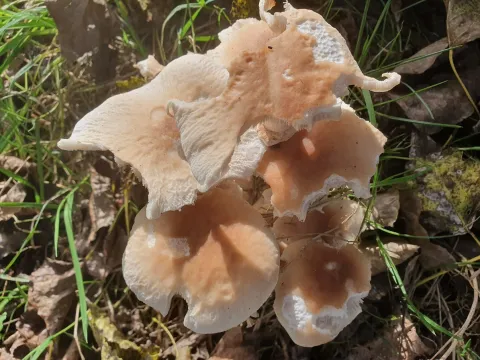In Depth
| Blushing Rosette |
|---|
Title: Blushing Rosette: Exploring the Enigmatic Beauty of Abortiporus biennisIn the tranquil depths of deciduous forests, where sunlight filters through the canopy and dances upon the forest floor, a captivating sight awaits the keen-eyed observer—the Blushing Rosette (Abortiporus biennis). With its distinctive appearance, intriguing ecological role, and unique features, this enigmatic fungus commands attention and admiration from nature enthusiasts and mycologists alike. Let's embark on a journey to uncover the mysteries of the Blushing Rosette and unravel its secrets. Introduction to the Blushing Rosette: Abortiporus biennis, commonly known as the Blushing Rosette or the Blushing Bracket, is a species of polypore fungus belonging to the family Polyporaceae. Native to Europe and North America, this striking fungus is typically found growing on the decaying wood of hardwood trees, particularly oaks (Quercus spp.), beech (Fagus spp.), and chestnut (Castanea spp.). Its distinctive rosette-shaped fruiting bodies and unique color-changing properties make it a fascinating subject of study and admiration among fungi enthusiasts. Distinctive Features: One of the most notable characteristics of Abortiporus biennis is its distinctive fruiting body, which forms in the shape of a rosette with overlapping, fan-shaped caps. The caps are fleshy and velvety to the touch, with a coloration that ranges from creamy white to pale yellow when young, gradually developing pinkish or reddish hues as they mature. This color change, which gives rise to the common name "Blushing Rosette," occurs when the fungus is bruised or handled, resulting in the release of pigments that react with oxygen in the air. The underside of the caps bears numerous small pores through which spores are released, a characteristic typical of polypore fungi. The spores are dispersed by wind or rain, allowing the fungus to colonize new substrates and continue its lifecycle. Ecological Role and Habitat: Abortiporus biennis is a saprophytic fungus, meaning it obtains nutrients by decomposing dead or decaying organic matter. In forest ecosystems, it plays a vital role in nutrient cycling and decomposition, breaking down the lignin and cellulose present in dead wood and returning essential nutrients to the soil. By recycling organic matter, the Blushing Rosette contributes to the health and vitality of forest ecosystems, supporting the growth of new plant life and providing habitat for a variety of organisms.The fungus is commonly found on fallen logs, stumps, and other woody debris in deciduous forests, where it thrives in cool, moist environments with ample humidity. Its preference for specific tree species and substrate types influences its distribution and abundance within forested habitats. Cultural Significance and Uses: While not widely utilized for culinary or medicinal purposes, Abortiporus biennis holds cultural significance as a symbol of natural beauty and ecological resilience. Its striking appearance and color-changing properties have inspired artists, photographers, and nature enthusiasts, who marvel at its intricate form and delicate hues.In some traditional healing practices, extracts or preparations derived from polypore fungi, including Abortiporus biennis, have been used for their potential medicinal properties, although scientific research on their efficacy and safety is limited. Conservation and Management: As with many fungal species, conservation efforts aimed at preserving the habitats and ecosystems where Abortiporus biennis occurs are essential for ensuring its continued survival and biodiversity. Sustainable forest management practices, including the preservation of old-growth forests and the maintenance of dead wood habitat, can help support populations of the Blushing Rosette and other fungi dependent on decaying wood for their lifecycle. Furthermore, public education and outreach efforts can help raise awareness about the ecological importance of fungi and the need to conserve their habitats for future generations. By fostering appreciation for the natural world and its inhabitants, we can inspire greater stewardship and conservation of our planet's rich biodiversity. Conclusion: n conclusion, the Blushing Rosette stands as a symbol of natural beauty and ecological resilience, its delicate form and color-changing properties capturing the imagination of observers and scientists alike. As we continue to explore and appreciate the wonders of the fungal kingdom, may we also recognize the importance of conserving and protecting the habitats that sustain these remarkable organisms. In the tranquil depths of the forest, the Blushing Rosette reminds us of the interconnectedness of all living things and the intricate web of life that sustains us. |

